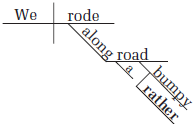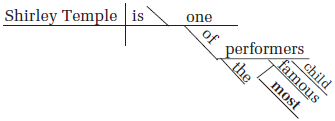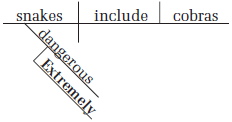Diagramming Adverbs
An adverb modifies or adds information to a verb, an adjective, or another adverb, telling "how," "where," "when," "why," and "how much" (or "to what extent"). Diagramming adverbs is similar to diagramming adjectives. We write the adverb on a slanted line under the word it modifies. Here we diagram sentences containing an adverb:
- Lucy skates nearby.

- Brent skis outside.

- The President dresses inside.

Examples 1
Diagram these sentences:
- Abe walks home.
- The raft floated downstream.
- Is Luisa rowing upstream?
Solutions
1. The adverb home tells "where" Abe walks, so we diagram the sentence like this:

2. We see that the adverb downstream tells "where" the raft floated, so we diagram the sentence like this:

3. We see that the adverb upstream tells "where" Luisa is rowing, so we diagram the sentence like this:

Diagramming Adverbs that Modify Adjectives or Other Adverbs
We have diagrammed adverbs that modify verbs. Now we will diagram adverbs that modify adjectives or other adverbs. As shown in the examples below, we place the adverb on a line underneath the adjective or other adverb which is modified:
- Max writes quite concisely.

An adverb may be a part of a prepositional phrase, as in the sentences below.
- We rode along a rather bumpy road.

The adverb rather modifies the adjective bumpy, which modifies the noun road, which is the object of the preposition along.
- Shirley Temple is one of the most famous child performers.

The adverb most modifies the adjective "famous" which modifies "performers" which is the object of the preposition "of."
Examples 2
Diagram this sentence:
- Extremely dangerous snakes include cobras.
Solutions
We place the adverb extremely underneath the adjective it modifies, dangerous, which describes "snakes."

not
Since the word not is an adverb, contractions like couldn't contain the adverb not. When we diagram contractions, we diagram n't as an adverb:
- I couldn't believe it!
- Didn't you experience hyperthermia?
- Doesn't this warrant concern?
Examples 3
Diagram these sentences:
- Don't ostracize her.
- People don't easily change their habits.
- Didn't he deliver the writ hastily?
- Slightly immoral politicians aren't guaranteed long political careers.
Solution
1. We place the adverbs not (n't) and easily under the verb phrase do change.
2. We place the adverbs not (n't) and easily under the verb phrase do change.
3. We place the adverbs hastily and n't underneath the verb "did deliver."
2. We place the adverb slightly underneath the adjective it modifies, immoral, which describes "politicians." Remembering that not is an adverb, we place n't, under the verb "are guaranteed."

Examples 4
Diagramming adverbs requires that we recognize adverbs in a sentence along with the words that they modify. In the sentences below, write each adverb and tell which word or phrase that it modifies.
- Greta carefully pressed soil around each tiny seedling.
- Gophers quickly devour too many tomato plants.
- Tomorrow, we shall set a trap.
- Unfortunately, I lost my cell phone yesterday.
- She misplaces her keys quite often.
Solutions
- The adverb carefully modifies the verb pressed, telling "how."
- The adverb quickly modifies the verb devour, telling "how." Also, the adverb too modifies the adjective many, telling "to what extent."
- The adverb Tomorrow modifies the verb shall set, telling "when."
- The adverb Unfortunately modifies the verb lost, telling "how." Also, the adverb yesterday modifies the verb lost, telling "when."
- The adverb often modifies the verb misplaces, telling "when." Also, the adverb quite modifies the adverb often, telling "to what extent."
Examples 5
Practice the recognition skills necessary for diagramming adverbs. In the sentences below, write each adverb and tell which word or phrase that it modifies.
- I shall gladly help you.
- Can Ted move the furniture easily?
- Later we heard a very loud boom.
- Downtown, someone had foolishly fired the cannon
- Then we discovered a rather large hole in the wall.
Solutions
- The adverb gladly modifies the verb shall help, telling "how."
- The adverb easily modifies the verb Can move, telling "how."
- The adverb Later modifies the verb heard, telling "when." Also, the adverb very modifies the adjective loud, telling "to what extent."
- The adverb Downtown modifies the verb fired, telling "where." Also, the adverb foolishly modifies the verb fired, telling "how."
- The adverb Then modifies the verb discovered, telling "when." Also, the adverb rather modifies the adjective large, telling "to what extent."